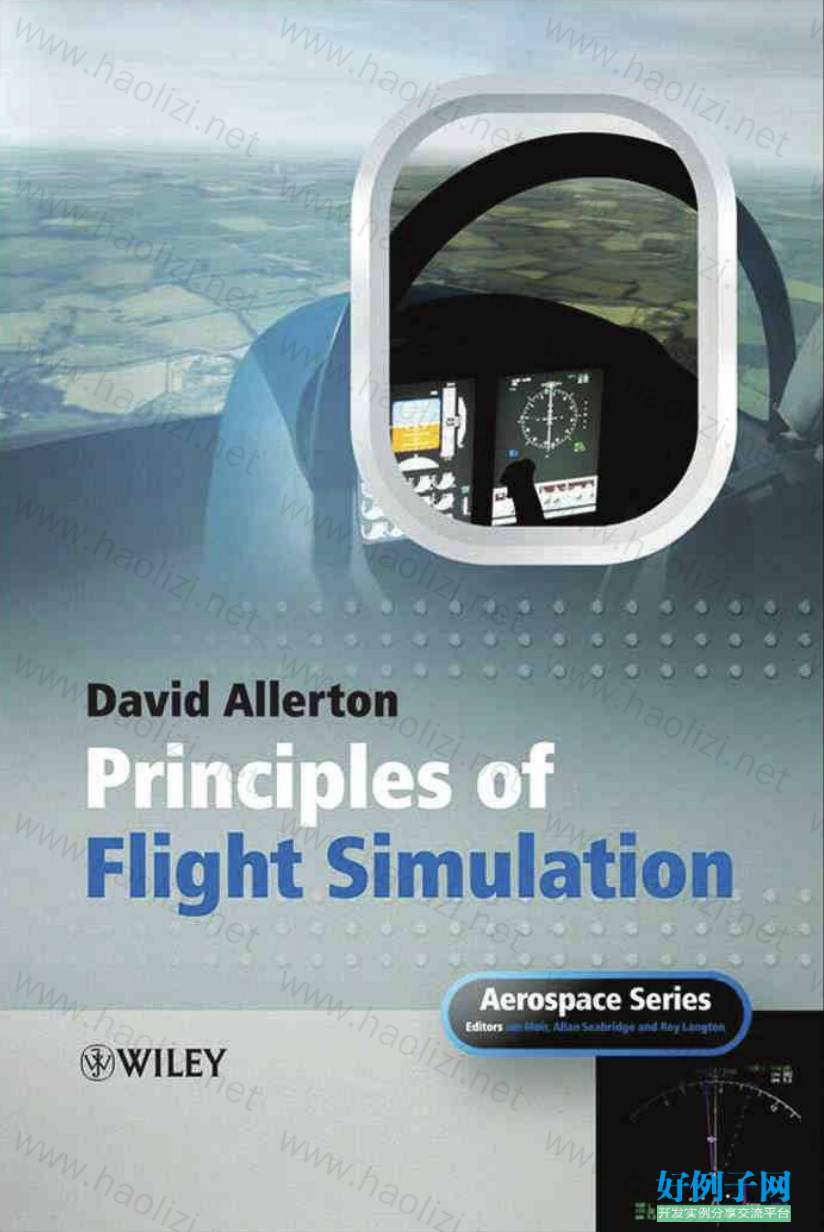实例介绍
【实例简介】Principles of flight simulation.pdf
【实例截图】

【核心代码】
Contents About the Author xiii Preface xv Glossary xvii 1 Introduction 1 1.1 Historical Perspective 1 1.1.1 The First 40 Years of Flight 1905–1945 1 1.1.2 Analogue Computing, 1945–1965 3 1.1.3 Digital Computing, 1965–1985 5 1.1.4 The Microelectronics Revolution, 1985–present 6 1.2 The Case for Simulation 9 1.2.1 Safety 9 1.2.2 Financial Benefits 10 1.2.3 Training Transfer 11 1.2.4 Engineering Flight Simulation 13 1.3 The Changing Role of Simulation 14 1.4 The Organization of a Flight Simulator 16 1.4.1 Equations of Motion 16 1.4.2 Aerodynamic Model 17 1.4.3 Engine Model 18 1.4.4 Data Acquisition 18 1.4.5 Gear Model 19 1.4.6 Weather Model 19 1.4.7 Visual System 20 1.4.8 Sound System 21 1.4.9 Motion System 21 1.4.10 Control Loading 22 1.4.11 Instrument Displays 23 1.4.12 Navigation Systems 23 1.4.13 Maintenance 24 1.5 The Concept of Real-time Simulation 24 1.6 Pilot Cues 27 1.6.1 Visual Cueing 28 1.6.2 Motion Cueing 29 1.7 Training versus Simulation 30 1.8 Examples of Simulation 32 1.8.1 Commercial Flight Training 32 viii Contents 1.8.2 Military Flight Training 34 1.8.3 Ab Initio Flight Training 34 1.8.4 Land Vehicle Simulators 34 1.8.5 Engineering Flight Simulators 35 1.8.6 Aptitude Testing 36 1.8.7 Computer-based Training 36 1.8.8 Maintenance Training 37 References 37 2 Principles of Modelling 41 2.1 Modelling Concepts 41 2.2 Newtonian Mechanics 43 2.3 Axes Systems 51 2.4 Differential Equations 53 2.5 Numerical Integration 56 2.5.1 Approximation Methods 56 2.5.2 First-order Methods 58 2.5.3 Higher-order Methods 59 2.6 Real-time Computing 63 2.7 Data Acquisition 67 2.7.1 Data Transmission 67 2.7.2 Data Acquisition 69 2.8 Flight Data 74 2.9 Interpolation 77 2.10 Distributed Systems 82 2.11 A Real-time Protocol 91 2.12 Problems in Modelling 92 References 96 3 Aircraft Dynamics 97 3.1 Principles of Flight Modelling 97 3.2 The Atmosphere 98 3.3 Forces 100 3.3.1 Aerodynamic Lift 100 3.3.2 Aerodynamic Side force 104 3.3.3 Aerodynamic Drag 105 3.3.4 Propulsive Forces 106 3.3.5 Gravitational Force 107 3.4 Moments 107 3.4.1 Static Stability 109 3.4.2 Aerodynamic Moments 111 3.4.3 Aerodynamic Derivatives 113 3.5 Axes Systems 114 3.5.1 The Body Frame 115 3.5.2 Stability Axes 117 3.5.3 Wind Axes 117 3.5.4 Inertial Axes 118 3.5.5 Transformation between Axes 118 3.5.6 Earth-centred Earth-fixed (ECEF) Frame 119 3.5.7 Latitude and Longitude 122 3.6 Quaternions 122 Contents ix 3.7 Equations of Motion 124 3.8 Propulsion 127 3.8.1 Piston Engines 128 3.8.2 Jet Engines 136 3.9 The Landing Gear 138 3.10 The Equations Collected 143 3.11 The Equations Revisited – Long Range Navigation 148 3.11.1 Coriolis Acceleration 150 References 154 4 Simulation of Flight Control Systems 157 4.1 The Laplace Transform 157 4.2 Simulation of Transfer Functions 161 4.3 PID Control Systems 163 4.4 Trimming 169 4.5 Aircraft Flight Control Systems 171 4.6 The Turn Coordinator and the Yaw Damper 172 4.7 The Auto-throttle 176 4.8 Vertical Speed Management 179 4.9 Altitude Hold 182 4.10 Heading Hold 185 4.11 Localizer Tracking 189 4.12 Auto-land Systems 191 4.13 Flight Management Systems 195 References 201 5 Aircraft Displays 203 5.1 Principles of Display Systems 203 5.2 Line Drawing 205 5.3 Character Generation 211 5.4 2D Graphics Operations 214 5.5 Textures 216 5.6 OpenGL® 219 5.7 Simulation of Aircraft Instruments 227 5.8 Simulation of EFIS Displays 235 5.8.1 Attitude Indicator 237 5.8.2 Altimeter 239 5.8.3 Airspeed Indicator 240 5.8.4 Compass Card 241 5.9 Head-up Displays 242 References 246 6 Simulation of Aircraft Navigation Systems 247 6.1 Principles of Navigation 247 6.2 Navigation Computations 250 6.3 Map Projections 252 6.4 Primary Flight Information 254 6.4.1 Attitude Indicator 254 6.4.2 Altimeter 255 6.4.3 Airspeed Indicator 255 x Contents 6.4.4 Compass 255 6.4.5 Vertical Speed Indicator 255 6.4.6 Turn Indicator 255 6.4.7 Slip Ball 255 6.5 Automatic Direction Finding (ADF) 255 6.6 VHF Omnidirectional Range (VOR) 257 6.7 Distance Measuring Equipment (DME) 258 6.8 Instrument Landing Systems (ILS) 259 6.9 The Flight Director 260 6.10 Inertial Navigation Systems 263 6.10.1 Axes 264 6.10.2 INS Equations 264 6.10.3 INS Error Model 268 6.10.4 Validation of the INS Model 272 6.11 Global Positioning Systems 274 References 282 Further Reading 283 7 Model Validation 285 7.1 Simulator Qualification and Approval 285 7.2 Model Validation Methods 288 7.2.1 Cockpit Geometry 291 7.2.2 Static Tests 291 7.2.3 Open-loop Tests 294 7.2.4 Closed-loop Tests 294 7.3 Latency 298 7.4 Performance Analysis 305 7.5 Longitudinal Dynamics 312 7.6 Lateral Dynamics 323 7.7 Model Validation in Perspective 328 References 329 8 Visual Systems 331 8.1 Background 331 8.2 The Visual System Pipeline 332 8.3 3D Graphics Operations 336 8.4 Real-time Image Generation 343 8.4.1 A Rudimentary Real-time Wire Frame IG System 343 8.4.2 An OpenGL Real-time IG System 347 8.4.3 An OpenGL Real-time Textured IG System 350 8.4.4 An OpenSceneGraph IG System 352 8.5 Visual Database Management 364 8.6 Projection Systems 370 8.7 Problems in Visual Systems 374 References 376 9 The Instructor Station 377 9.1 Education, Training and Instruction 377 9.2 Part-task Training and Computer-based Training 378 9.3 The Role of the Instructor 379 Contents xi 9.4 Designing the User Interface 380 9.4.1 Human Factors 382 9.4.2 Classification of User Operations 383 9.4.3 Structure of the User Interface 384 9.4.4 User Input Selections 388 9.4.5 Instructor Commands 394 9.5 Real-time Interaction 398 9.6 Map Displays 404 9.7 Flight Data Recording 409 9.8 Scripting 413 References 421 10 Motion Systems 423 10.1 Motion or No Motion? 423 10.2 Physiological Aspects of Motion 425 10.3 Actuator Configurations 428 10.4 Equations of Motion 432 10.5 Implementation of a Motion System 436 10.6 Hydraulic Actuation 443 10.7 Modelling Hydraulic Actuators 447 10.8 Limitations of Motion Systems 451 10.9 Future Motion Systems 453 References 454 Index 457
好例子网口号:伸出你的我的手 — 分享!
小贴士
感谢您为本站写下的评论,您的评论对其它用户来说具有重要的参考价值,所以请认真填写。
- 类似“顶”、“沙发”之类没有营养的文字,对勤劳贡献的楼主来说是令人沮丧的反馈信息。
- 相信您也不想看到一排文字/表情墙,所以请不要反馈意义不大的重复字符,也请尽量不要纯表情的回复。
- 提问之前请再仔细看一遍楼主的说明,或许是您遗漏了。
- 请勿到处挖坑绊人、招贴广告。既占空间让人厌烦,又没人会搭理,于人于己都无利。
关于好例子网
本站旨在为广大IT学习爱好者提供一个非营利性互相学习交流分享平台。本站所有资源都可以被免费获取学习研究。本站资源来自网友分享,对搜索内容的合法性不具有预见性、识别性、控制性,仅供学习研究,请务必在下载后24小时内给予删除,不得用于其他任何用途,否则后果自负。基于互联网的特殊性,平台无法对用户传输的作品、信息、内容的权属或合法性、安全性、合规性、真实性、科学性、完整权、有效性等进行实质审查;无论平台是否已进行审查,用户均应自行承担因其传输的作品、信息、内容而可能或已经产生的侵权或权属纠纷等法律责任。本站所有资源不代表本站的观点或立场,基于网友分享,根据中国法律《信息网络传播权保护条例》第二十二与二十三条之规定,若资源存在侵权或相关问题请联系本站客服人员,点此联系我们。关于更多版权及免责申明参见 版权及免责申明



网友评论
我要评论